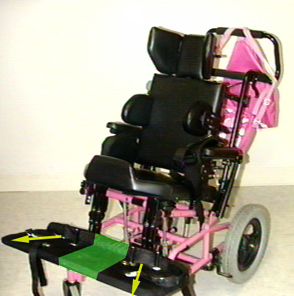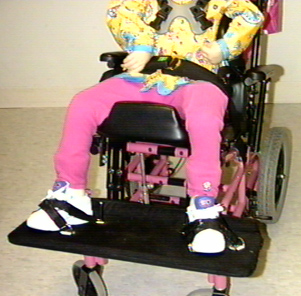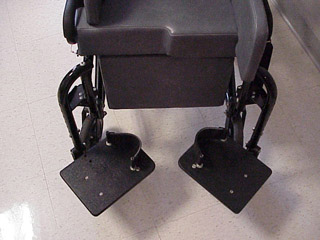|
The "Hip Happy Chair"
from the
Seating & Special Equipment Clinic
Hips under tension from spastic muscle are in danger of deformation. In "sitters" with spasticity (those unable to stand and walk supported) the rate of
hip deformation of the type leading to dislocation is between 25% to 50%. That is a nasty fact.
Then add to that, the typical wheel chair that is a shrine of worship to Euclid. Somehow somebody was totally overtaken with right angles and square this
and square that. There are no right angles or squares in biology. Sorry. Square chairs are uncomfortable. Legs with nice parallel knees together and nice square knees and hips are set up for trouble.
The 'Mary' or 'Happy Hip' Chair is not a product nor a part to be ordered. It is a concept to be used in setting up any chair for a child with severe
spastic leg problems. It is a prevention recipe.
 The chair configuration was devised to maximize space between the knees and takes into account real biologic foot positioning. The chair configuration was devised to maximize space between the knees and takes into account real biologic foot positioning.
The key elements are:
1. Wide Trial Foot Board - a temporary test foot rest that extends 6 inches beyond the frame to each side
but within the wheel base. There are holes to allow straps for foot positioning in outward rotation.
The section in green represents the
space that would be present if swing away foot rests were used. This test board is attached to the existing foot rests. For kids who stand from their seats, it gets in the way.
The typical foot rest locks-in, ka-klunk, when it is straight ahead, adjacent the other foot rest. Instead, make the lock point an outwardly pointing angle. For
many chairs, merely altering the lock attachment to the swing bar will do it. It isn't a different piece but a more out rotated way of positioning it. The foot rests lock before they come together.
2. Pommel - a custom contoured pommel set about 45 degrees for each leg from mid-line.
3. Femur rotation is controlled by Velcro thigh cuffs attached to the chair or seat
base. Cuffs are padded by loop and lock system. Size is as per child size. Side thigh pads ("thigh adductors" gak) either have to go or, better, get angled to be
close at the hips and wide nearer the knees. Some kids do not even need the pommel if the simple straps can be positioned (depends on where the metal of the chair is).
These alterations can be adapted to any standard wheel chair, but only with  difficulty to a "sports frame". difficulty to a "sports frame".
Other adaptations are as per other needs. Wide abduction requires that the hips have passive movement to allow this positioning.
Typically, this chair configuration is used after some form of intervention such as lengthening or nerve block etc..
We advise the test foot rest for vendors who are not comfortable with the position.
They can fiddle with the details on the board then modify the metal parts with confidence.
Also note: If knees are apart AND if feet are straight ahead, then the knees are being twisted. Normal feet do not point straight ahead.
 By simply redrilling the foot rest mount post so that the locking click locks the foot rests at this position rather than with the feet side by side ( then reorienting the heel
and foot straps), an existing chair can be made hip friendly. The side guides may need to be angled outward a bit as well. By simply redrilling the foot rest mount post so that the locking click locks the foot rests at this position rather than with the feet side by side ( then reorienting the heel
and foot straps), an existing chair can be made hip friendly. The side guides may need to be angled outward a bit as well.
See Chair details
|

